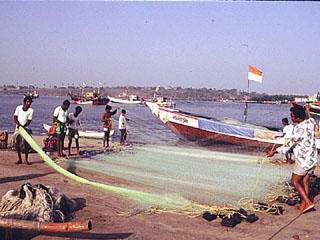Other than that.....have been travelling around Mumbai for last 2 weeks, and am really charmed at the 'Old-beauty' of the city.....but aghast at some of the 'New-beastlies' mushrooming up now.
Well, had gone down to South Mumbai.......am still floored by the architectural wonder called the 'Victoria Terminus(now, Chatrapati Shivaji Terminus)'. So I am generally quoting the history and background of profound architectural structures, and places of general interest.....in the following paragraphs.....

"Modeled on the lines of the St Pancras Station in London, Victoria Terminus is undoubtedly the Raj's piece de resistance, Complete with carved stone friezes, stained glass windows and flying buttresses. It is Gothic architecture at its best, an awesome edifice that most citizens view with deep pride. At the top of the central dome stands the triumphant figure of Progress. The station was christened to commemorate Victoria Jubilee Day in 1887 when India's first steam engine puffed out to neighboring Thane, about 45 kms away. Today it has been rechristened Chhatrapati Shivaji Terminus after the Maratha warrior. And the old steam engines have been replaced by electric ones. But to the 2.5 million commuters who push past its massive portals everyday, this is still VT, the pulse of a throbbing city".
The sea which stretches along Mumbai is a wonderful sight in itself. Though most beeches are thronged by people....yup, lotsa people, people everywhere;) , its still lovely to spend an evening on the beech.

"Over two thousand years ago, Mumbai was an archipelago of seven islands, inhabited by the kolis. These tribal fisherfolk still live here in tightly knit communities that the passing centuries have scarcely touched. The best place to see them is in the 600-year-old Worli Fishing Village that stands on a sliver of land jutting into the sea. Plunge into one of its winding gullies and you will instantly be assailed by the smell of drying fish, and colourful koli women, their dark skins offset by chunky tribal jewellery. At the end of the village is a small Portuguese fort with remnants of an old armoury, soldiers' barracks and thick ramparts. Before the Raj, when Portugal ruled Mumbai, this was a strategic vantage point to counter attacks from the sea".
Tats, enough for the day i suppose......will get back to reading the book- "A Short History of Nearly Everything" by Bill Bryson.......pretty interesting book, this one.
So, ciao till next time....Harsha
No comments:
Post a Comment